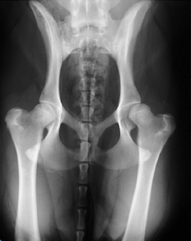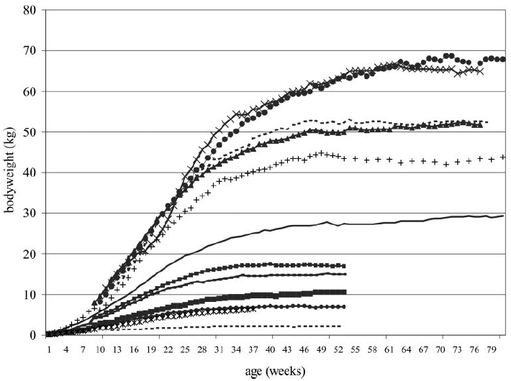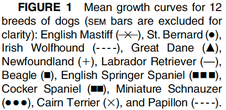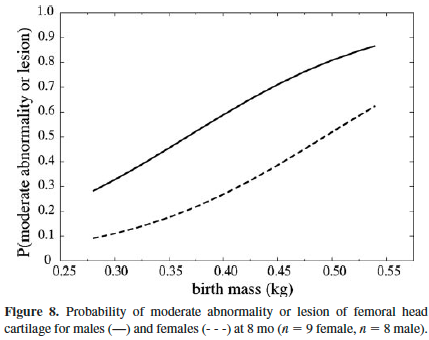| Although we think of hip dysplasia (HD) as a "large breed problem", a small dog - the Pug - is right at the top of the OFA rankings. In fact, I have argued in a previous post that that it's not the size of the dog, but the "robustness" of the dog that seems to have the best association with ranking on the OFA "hip list". I also pointed out that there was clear evidence that food consumption affected the risk of developing HD in an experiment done by Purina. Labrador Retriever puppies raised on a restricted diet weighed less than their litter mates as adults, they developed signs of dysplasia much later in life, and they also lived longer. Clearly, how much the dogs were fed from puppy to adult affected the risk of developing dysplastic hips. But is the effect due to growth rate or weight? |
But we can look at the effect of size without the confounding effect of food consumption if we look at newborn puppies. A study of Newfoundlands, Labradors, Leonbergers, and Irish Wolfhounds followed dogs from birth until up to 9 years (Vanden Berg-Foels et al 2006). They found that the weight of puppies at birth was affected by litter size: smaller litters had puppies that weighed more at birth. Furthermore, these larger pups had a higher risk of abnormalities or lesions of the hip cartilage by 8 months. This is despite the fact that the pups that were smaller at birth had exponential "catch-up" growth, so that by 12 days there were no longer differences in weight due to litter size.
| The more puppies weighed at birth, the more likely they were to have abnormalities or lesions of the cartilage on the head of the femur by the time they were 8 months old. Also, for pups of a specific size, males had a higher risk of abnormalities of lesions than females. So a male puppy weighing more than 0.4 kg at birth, or a female weighing more than 0.5 kg, had a greater than 50% risk of developing hip abnormalities. |
This experiment suggests that it is the weight of the puppy very early in life, and not growth rate, that is the significant factor in the development of HD.
As the authors of this study point out, heavier puppies could challenge the capacity of the immature connective tissues and skeleton for support. If this allows some laxity of the head of the femur, the contact area over which force is distributed would be reduced, putting greater stress on the areas of contact. As the weight of the animal continues to increase with growth, a less than perfect fit of the head of the femur in the hip socket could produce a viscous cycle of damage and greater laxity that could eventually manifest as dysplastic hips.
They conclude that "These results support the hypothesis that increased body weight during the critical early postnatal period was sufficient to alter the course of hip development and result in measurable degenerative changes at adulthood."
So we're left with these thoughts:
- Puppies from larger litters weigh less at birth
- Puppies that weigh less at birth grow faster and catch up with the larger pups
- Puppies from smaller litters weigh more at birth, don't grow as fast as pups from larger litters, and are more likely to show degenerative changes in the hip joint when they get older
The bottom line:
- The risk of hip dysplasia is related to how much a puppy weighs when it is born.
Smaller litters have larger puppies.
Larger puppies are more likely to develop hip dysplasia.
- Hawthorne AJ, D Booles, PA Nugent, G Gettinby, and J Wilkinson. Weight changes during growth in puppies of different breeds. Journal of Nutrition 134: 2027S-2030S.
- Vanden Berg-Foels WS, RJ Todhunter, SJ Schwager, and AP Reeves. 2006. Effect of early postnatal body weight on femoral head ossification on set and hip osteoarthritis in a canine model of developmental dysplasia of the hip. Pediatric Research 60: 549-554.
If you would like to participate in the testing program, please check out the project on the Facebook Page for the Hip Dysplasia Project.
ICB's online course, "Understanding Hip & Elbow Dysplasia".
For more info and to register, go to -
https://www.instituteofcaninebiology.org/hip-elbow-dysplasia.html
ICB's online courses.
******************************
Visit our Facebook Groups
ICB Institute of Canine Biology
...the latest canine news and research
ICB Breeding for the Future
...the science of animal breeding





